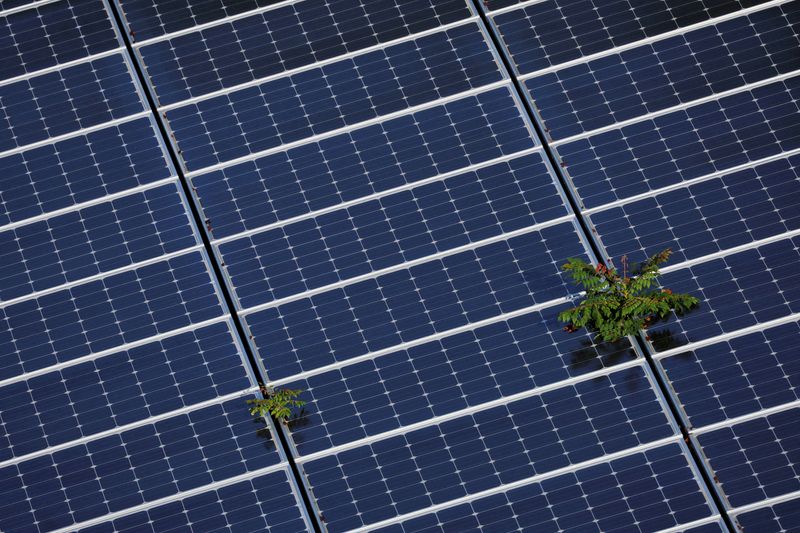
© Reuters. FILE PHOTO: Plants grow through an array of solar panels in Fort Lauderdale, Florida, U.S., May 6, 2022. REUTERS/Brian Snyder/File Photo
By Valerie Volcovici and Nichola Groom
WASHINGTON/LOS ANGELES (Reuters) -U.S. regulators on Thursday approved proposals to speed up the connection of new power projects to the electric grid, reforms that could ease a growing backlog of requests from wind and solar energy developers.
Long waits for transmission interconnection have hobbled the deployment of big renewable energy projects that the Biden administration wants built to move away from fossil fuels like coal and and help combat climate change.
Today there is more than 2,000 gigawatts of renewable power waiting to be connected to the grid – nearly double the amount of current U.S. generation capacity.
“This rule is a major first step in our journey to addressing transmission reform,” Federal Energy Regulatory Commission Acting Chairman Willie Phillips said at a press conference on Thursday following the vote.
The FERC final rule will enact several changes to the burdensome interconnection process, including shifting it from a “first come, first served” to a “first ready” approach – meaning projects that are prepared with land rights and permits would move ahead of those that are not.
New power generators and battery storage resources must go through a complex process before they can be connected. The process includes multiple studies of how their projects will affect the grid, and currently takes an average of five years, according to FERC.
Grid operators have been overwhelmed with requests as more and more wind and solar resources have been developed to displace aging fossil fuel plants.
The new rule will impose financial and other conditions to secure a place in the interconnect queue and establish penalties of up to $2,500 per day for grid operators if they fail to complete interconnection studies on time. It will also allow projects to be studied in clusters instead of one by one.
The unanimous vote comes nearly one year after landmark legislation aimed at boosting renewable energy projects called the Inflation Reduction Act (IRA) became law.
The solar energy trade group Solar Energy Industries Association (SEIA) said it was pleased with the final rule, but that more reforms were needed.
“While this is a decisive step forward, we have a long way to go before we clear the two terawatts of generation and storage that are trapped in the interconnection queue,” Melissa Alfano, SEIA’s director of energy markets, said in a statement.
The interconnection rule is part of a broader package of reforms FERC is working on in coming months to help hasten the deployment of renewable energy and storage. It is also seeking to finalize proposals this year to improve planning and cost allocation for transmission lines.
Stay connected with us on social media platform for instant update click here to join our Twitter, & Facebook
We are now on Telegram. Click here to join our channel (@TechiUpdate) and stay updated with the latest Technology headlines.
For all the latest Business News Click Here
For the latest news and updates, follow us on Google News.
